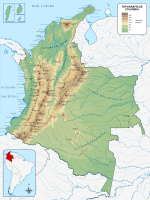Portal:Colombia
Colombia articles: History | Politics | Geography | Provinces | Economy | People | Culture | Café de Colombia | and much more...
The Colombia Portal
Colombia, officially the Republic of Colombia, is a country primarily located in South America with insular regions in North America. The Colombian mainland is bordered by the Caribbean Sea to the north, Venezuela to the east and northeast, Brazil to the southeast, Ecuador and Peru to the south and southwest, the Pacific Ocean to the west, and Panama to the northwest. Colombia is divided into 32 departments. The Capital District of Bogotá is also the country's largest city hosting the main financial and cultural hub. Other major urbes include Medellín, Cali, Barranquilla, Cartagena, Santa Marta, Cúcuta, Ibagué, Villavicencio and Bucaramanga. It covers an area of 1,141,748 square kilometers (440,831 sq mi) and has a population of around 52 million. Its rich cultural heritage—including language, religion, cuisine, and art—reflects its history as a colony, fusing cultural elements brought by immigration from Europe and the Middle East, with those brought by the African diaspora, as well as with those of the various Indigenous civilizations that predate colonization. Spanish is the official language, although Creole, English and 64 other languages are recognized regionally. Colombia has been home to many indigenous peoples and cultures since at least 12,000 BCE. The Spanish first landed in La Guajira in 1499, and by the mid-16th century, they had colonized much of present-day Colombia, and established the New Kingdom of Granada, with Santa Fé de Bogotá as its capital. Independence from the Spanish Empire was achieved in 1819, with what is now Colombia emerging as the United Provinces of New Granada. The new polity experimented with federalism as the Granadine Confederation (1858) and then the United States of Colombia (1863), before becoming a republic—the current Republic of Colombia—in 1886. With the backing of the United States and France, Panama seceded from Colombia in 1903, resulting in Colombia's present borders. Beginning in the 1960s, the country has suffered from an asymmetric low-intensity armed conflict and political violence, both of which escalated in the 1990s. Since 2005, there has been significant improvement in security, stability, and rule of law, as well as unprecedented economic growth and development. Colombia is recognized for its healthcare system, being the best healthcare in Latin America according to the World Health Organization and 22nd in the world. Its diversified economy is the third-largest in South America, with macroeconomic stability and favorable long-term growth prospects. Colombia is one of the world's seventeen megadiverse countries; it has the highest level of biodiversity per square mile in the world and the second-highest level overall. Its territory encompasses Amazon rainforest, highlands, grasslands and deserts. It is the only country in South America with coastlines (and islands) along both the Atlantic and Pacific oceans. Colombia is a key member of major global and regional organizations including the UN, the WTO, the OECD, the OAS, the Pacific Alliance and the Andean Community; it is also a NATO Global Partner and a major non-NATO ally of the United States. (Full article...) Selected article -The Armero tragedy (Spanish: Tragedia de Armero [tɾaˈxeðja ðe aɾˈmeɾo]) occurred following the eruption of the Nevado del Ruiz stratovolcano in Tolima, Colombia, on November 13, 1985. The volcano's eruption after 69 years of dormancy caught nearby towns unprepared, even though volcanological organizations had warned the government to evacuate the area after they detected volcanic activity two months earlier. As pyroclastic flows erupted from the volcano's crater, they melted the mountain's glaciers, sending four enormous lahars (volcanically induced mudflows, landslides, and debris flows) down its slopes at 50 km/h (30 mph). The lahars picked up speed in gullies and engulfed the town of Armero, killing more than 20,000 of its almost 29,000 inhabitants. Casualties in other towns, particularly Chinchiná, brought the overall death toll to 23,000. Footage and photographs of Omayra Sánchez, a young victim of the disaster, were published around the world. Other photographs of the lahars and the impact of the disaster captured attention worldwide and led to controversy over the degree to which the Colombian government was responsible for the disaster. A banner at a mass funeral in Ibagué read, "The volcano didn't kill 22,000 people. The government killed them." (Full article...)Related portalsCategoriesSelected biography -Rosibel García Mina (born 13 February 1981) is a Colombian track and field athlete who specialises in middle-distance running events. She has represented her country at the Summer Olympics and has also competed at the World Championships in Athletics. She is the current Colombian record holder for the 800 metres and former 1500 metres record holder. The 800 m record was set at the 2008 Beijing Olympics, where she became the first Colombian woman ever to reach the semi-finals of the event. She was one of South America's foremost female middle-distance runners in the first decade of the 21st century, having been a three-time South American Champion in the 1500 m and a two-time champion over 800 m. In addition to the medals she has won at the Bolivarian Games and various Central American competitions, she won a silver and bronze medal at the 2007 Pan American Games. (Full article...)Did you know (auto-generated)
General imagesThe following are images from various Colombia-related articles on Wikipedia.
Selected pictureLargest cities
TopicsNew articlesThis list was generated from these rules. Questions and feedback are always welcome! The search is being run daily with the most recent ~14 days of results. Note: Some articles may not be relevant to this project.
Rules | Match log | Results page (for watching) | Last updated: 2024-05-28 20:32 (UTC) Note: The list display can now be customized by each user. See List display personalization for details.
WikiprojectsThings you can doIf you are interested in helping with this portal, please join WikiProject Colombia or one of its child projects: Article requests
History (High priority)
Society
Scouting
People (Medium priority)Physical geography
Media (Medium Priority)Government and political affairs (High priority)
Wikipedia's portalsDiscover Wikipedia using portals Sources | |||||||||||||||||||||||||||||||||||||||||||||||||||||||||||||||||||||||||||||||||||||||||||||||||||||||||||||||



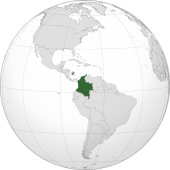
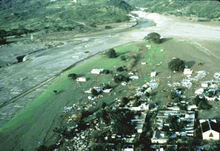














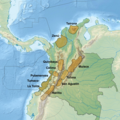




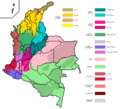








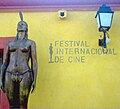




![Image 3Tall ship ARC Gloria, insignia of Colombia. She is a training ship and official flagship of the Colombian Navy.[1]](http://upload.wikimedia.org/wikipedia/commons/thumb/e/eb/ARC_Gloria_by_Will_White.png/120px-ARC_Gloria_by_Will_White.png)








